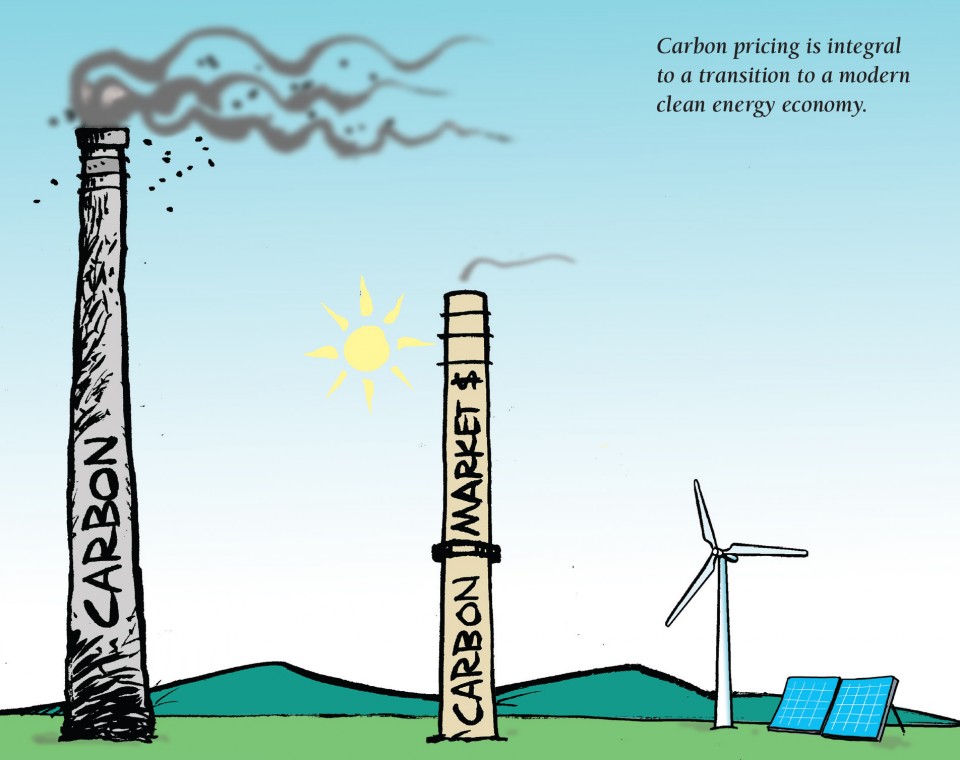
Neo-classical economics tells us that markets reduce costs and increase social welfare. It also teaches that pollution not properly accounted for is a classic economic externality. That is, if clean air and clear water are not properly valued, degrading them reduces economic efficiency, impacts social welfare, and increases social costs. Pollution not-paid-for represents a market failure.
In the early 1990s, officials in President George H.W. Bush’s administration pioneered the concept of using markets for pollution rights to fix this inefficiency in order to arrest the primary causes of acid rain. The program was designed to achieve low-cost pollution reductions by creating a SO2 trading market, and ended up reducing acid rain at costs much lower than had been projected in 1990.
Today, nearly a quarter century after the launch of the acid rain program, the idea of pollution markets has evolved. Markets for another pollutant—carbon—now operate in ten U.S. states and 50 jurisdictions around the world. Next year, when China’s national carbon trading system goes into effect, economies representing nearly half of global GDP will have in place a carbon emissions market system of some type. So, as we contemplate changes to our electricity sector, can we build on our experience with pollution trading markets to address global challenges and minimize economic and environmental risks—and even comply with EPA’s Clean Power Plan—using carbon markets? I think the answer is “Yes.”
What have we learned after 25 years of pricing pollution? Quite a bit, actually. In our recently released paper Carbon Markets 101: “How-to” Considerations for Regulatory Practitioners, we have distilled best practices. If governments and market participants keep such guidelines and principles in mind, they can create and monitor successful carbon emission markets.
Effective carbon markets share several critical elements. Among them:
- Effective carbon markets are created, implemented, and periodically reviewed using a transparent process that elicits energy and environmental expertise and stakeholder feedback. This gives utilities, power plants owners, investors, and the public confidence that there are no information disparities that would allow for unfair—or perhaps even illegal—access to critical market data. Transparency is particularly important during program design and program launch, because an open process helps regulated entities prepare, plan, and adjust to new programs’ impact on their operations before the programs go into effect.
- Effective carbon markets are created using modeling scenarios to understand the range of potential costs, benefits, and risks, to consider least-cost options, and to identify market designs that allow participants to manage the risks of energy market volatility. Looking at different model runs can illuminate the risks of different compliance approaches. Market development is more sound if the costs, benefits, and risks of different approaches—e.g., rate-based (emissions/energy) versus mass-based (total emissions cap) designs, existing-source-only coverage versus new-and-existing-source coverage, and using renewables, efficiency, natural-gas, or nuclear plants for compliance—are analyzed under a robust range of market situations and differing energy resource investments scenarios.
- Effective carbon markets contain safeguards to protect against market manipulation, such as a well-designed registry and tracking system, an expert market monitor, and informal information sharing with federal regulators.
EPA has suggested that compliance with the Clean Power Plan can produce significant long-term savings for ratepayers and consumers. But whether that happens depends on how states implement the rule. Innovative states can use cost-effective programs that capture efficiencies and harness least-cost options (something carbon markets can help with)—or regulators can cling to strained 20th-century approaches and ways of doing business. One lesson is clear: public health, our economies, and the environment will suffer if we don’t correctly value air, water, and land.
Careful and transparent analysis with stakeholders will reveal that not all regulatory systems are equally efficient and economically beneficial for energy consumers and state economies.
Careful and transparent analysis with stakeholders will reveal that not all regulatory systems are equally efficient and economically beneficial for energy consumers and state economies. Some regulatory approaches are riskier than others, and no change in regulatory landscape or market structure is entirely cost-free in the short run. However, there are certainly regulatory solutions that will produce economic growth and jobs, both of which are benefits in the short and long run.
The good news is that, collectively, we have far more experience with pollution markets and, more recently, carbon markets, than we had 25 years ago. These markets are here and they work well—particularly when combined with a robust set of complementary programs—and we now have plenty of wisdom to draw upon for 21st-century energy and environmental solutions.
